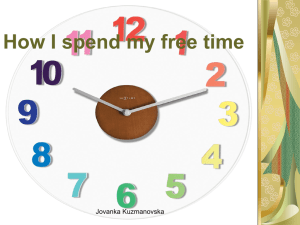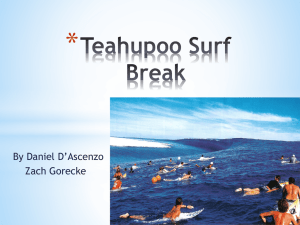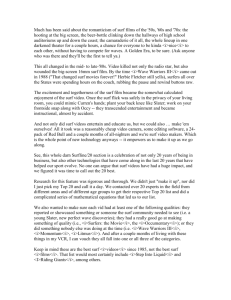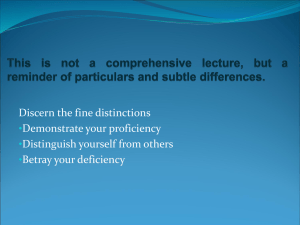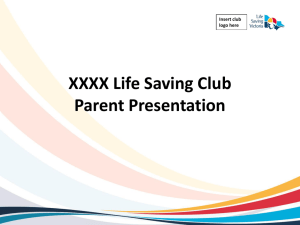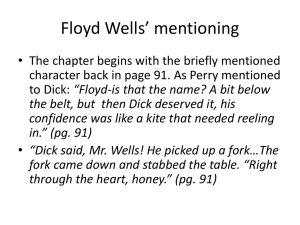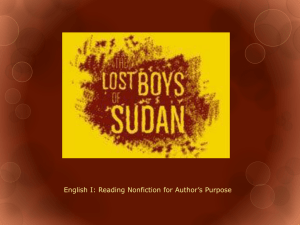Surfing Safari PowerPoint with No Media
advertisement
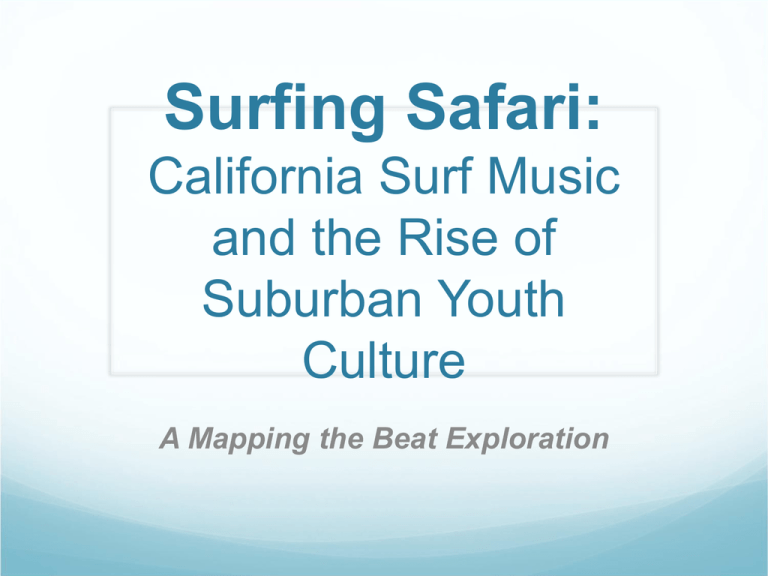
Surfing Safari: California Surf Music and the Rise of Suburban Youth Culture A Mapping the Beat Exploration Project Web Site http://surfingsafari.wordpress.com/ “Music is as close to surfing as you can get without actually going in the water.” Describe sounds you might hear if you were out in the ocean, past the breakers, sitting up on your surfboard waiting for a big wave to roll in. How are these sounds similar to music? What is Surf Music? What characteristics, images, song titles, artists, etc come to mind? Is surf music distinctly American? In other words, did it originate here? Did the sport of surfing originate here? How do you think surfing itself and its historical trends might have This lesson will continue to explore these questions as well as answers to the following questions: 1. How Does the Physical and Social Character of a Region Shape Popular Music? 2. How Does Popular Music Shape the Cultural Character of the Region? 3. How Has Surf Music Continued to Evolve and Adapt through the Decades? Dick Dale and His Del-Tones Jack Johnson 1953 2003 Surfin’ USA Del Mar, Ventura, Santa Cruz, Trestles, Narrabeen, Manhattan, Doheny, Haggerties, Swamies, Pacific Palisades, San Onofre, Sunset, Redondo, La Jolla, Wa’imea Bay What did the physical/geographical character of Southern California look like before 1950? Extensive beaches, consistent waves, tolerably warm water, & sunny weather make CA one of world’s greatest surf locations, especially the region between Malibu and San Onofre. Surf origins in Polynesia, Hawai’i, the world’s most isolated archipelago, with the biggest waves every winter = surf magnet. Only way to get there through the 1930s was by boat making California and Australia among the most geographically conducive for surfing to spread. Historic and geographical considerations, patterns of migration, socio-economic conditions, & social values converged in 1960s CA to launch surfing into an international craze. Since the disastrous 1969 oil spill in Santa Barbara channel, surfers more involved in environmental and ecological concerns. In many ways, it was the music that turned the world’s attention to the beach. History of Surfing in California Hawai’i-California Connection Early Polynesian surfing American and European tourism to Hawai’i after 1893 Surfing popularization in early 20th century via Jack London and Alexander Ford Hume First of many surfing clubs, Hume’s Outrigger Canoe Club Duke Kahanomoku What is Hawai’ian Music? Hawa’iian music has a very distinctive sound. Can you identify the instruments being played? Listen to the Hawaiian Ukulele Listen to the Hawaiian Steel Guitar Ukulele Players on a CA Beach Surfing Boom Early 1930s Rise of Surfing Clubs and Surfing Photography Post World War II Migration to California and Economic Prosperity First Surf Films Bud Browne John Severson Bruce Brown Technological Innovations: Light-Weight Surfboards Transistor Radio Wet Suit As the population of surfers multiplied in California, Hawai’i and elsewhere around the world, the images and popular representation of surfing narrowed. Opening in 1959, “Gidget” the movie touched off a worldwide sensation. The story stemmed from the real life experiences Kathy “Gidget” Kohner who, although never a serious surfer, was a Malibu regular. Click below to watch a brief scene from the 1959 film Gidget. By the 1960s, surf culture had become a fullfledged industry, comprised of music, movies, magazines, mass produced boards, clothes and gear and surf music especially played no small part in the surf craze. Among the first surf bands to emerge in the 1950’s were. . . Dick Dale & the Del-Tones The Surfaris An excerpt from Surfin’ Guitars by Robert Dalley: “ Instrumental surf music was a unique style of music that first appeared in the early sixties. What made it unique was that it developed around the culture and language of the sport of surfing. The music was an attempt on the part of the musician to convey the feeling and rhythm of surfing to others through the music. Although this music was mostly a regional phenomenon centered on the West Coast of Southern California, its presence was felt worldwide where instrumental music knew no language barriers. Dick Dale is credited with introducing this style of music and . . . seemed to get things started with ‘Let’s Go Trippin’ released in 1961. It was Dick Dale who influenced many local artists and groups.” Listen to Dick Dale's Let's Go Trippin’ Dick Dale Dick Dale is known as the “King of the surf guitar,” and founder of the “surf sound.” Dick Dale took up surfing in the late 1950s, but had greater success expressing his love of the sport on his instrument. Born Richard Anthony Monsour, in Beirut, Lebanon, to a Polish mother and Lebanese father, Dale’s musical influences stemmed, not from Polynesia, but from his roots as his music re-worked the Middle-Eastern scales taught to him by his uncle, who played the oud. Dale and his band the Del-Tones drew large audiences, touring around southern California and inspired a host of other local bands from Jan and Dean to the Surfaris to experiment with the instrumental guitar sound. Playing to youth-filled crowds in large halls these bands resonated with the booming, post-War youth culture in southern California from the beaches inland to Ontario and Riverside. Dale wrote the soundtrack to the popular “Beach Party” film, but despite his local success and status as founder of the widely popular genre, global attention clamored to Brian Wilson’s and his Click on the image below to watch Dick Dale & the Del Tones perform Miserlou Iconic California surf musicians of the 1960s created a wave of influence on Rock & Roll and popular music across the country. Their music was the sound of the people, intended to inspire and express the seemingly collective desire for independence and that drive to catch the biggest wave. This music took two forms simultaneously, One was instrumental rock, with a guitar playing the lead line (melody) as with such musicians as Dick Dale, The Surfaris, The Ventures, and The Chantays Listen to Pipeline by The Chantays Members Jim Fuller, Pat Connolly, Ron Wilson, Bob Berryhill, and Jim Pash of Glendora, California, met in junior high school and were each directly influenced by Dick Dale’s performance style and early success. The Surfaris biggest hit “Wipeout,” completed in just two takes, reached number two on the Billboard charts in 1963 and remained in the top 100 for an inimitable total of 189 weeks. It was far and away the most successful hit to come out of the instrumental surf music genre. The Surfaris While sound could provide the imagery of a wave coming crashing down or the sound of a surfer’s “Wipeout” as The Surfaris were so craftily able to create... Lyrics now provided an added means of expression. . . “I have watched you on the shore, standing by the ocean’s roar”– Surfer Girl lyrics, Beach Boys The second form was songs about surfing, what is known as “vocal surf pop” introduced by The Beach Boys and Jan & Dean. Listen to Jan & Dean’s Surf City The Beach Boys Originally comprised of brothers Brian, Dennis, and Carl Wilson along with their cousin Mike Love and friend Al Jardine, The Beach Boys formed in 1961 in Hawthorne, California. They were initially managed by the Wilsons’ father (Murry) who championed them to signing with Capitol Records in 1962. But the music of The Beach Boys was much different from the then established instrumental guitar- and drum-driven surf music of artists like Dick Dale and Eddie Bertrand. The Wilson boys grew up singing around the piano with their father at the keys, listening intently to and imitating the close vocal harmonies of such groups as The Four Freshmen. Their music began and continued to flourish as more of a “vocal surf pop” genre that happened to be about the subject of surfing (Brian wrote lyrics reflecting the Southern Californian youth surf culture) than falling under the label of “surf music.” Compare and List Similarities Between Miserlou and Two More Iconic Surf Songs Wipe Out by The Surfaris Surfin’ Safari by The Beach Boys What did you notice about. . . Melodies Rhythms Instruments used Characteristic sounds Emotions expressed Other similarities that come to mind? How has surf music continued to evolve and adapt through the decades? 1950-1960s Dick Dale & His Del-Tones The Surfaris 2000-2010s Ka’au Krater Boys, Surf Jack Johnson, Sitting, Waiting, Wishing The Chantays Jan & Dean The Beach Boys Donavan Frankenreiter, Lovely Day Tristan Prettyman, Love, Love, Love Conclusion Historic and geographical considerations, patterns of migration, socio-economic conditions, and social group values converged to make California in the 1960s the right place and time for surfing to burst onto the scene of America’s consciousness. Southern California launched surfing into an international craze and it remains an important component of California’s popular culture. In many ways, it was the Surfing Safari Collaborators Liane Brouillette, Principal Investigator Maureen Burns, Arts Education Specialist Barbara Cohen, Humanities Specialist Julie Cohen, California Historian Tim Cooley, Ethnomusicologist Stephanie Streja, Music Educator
